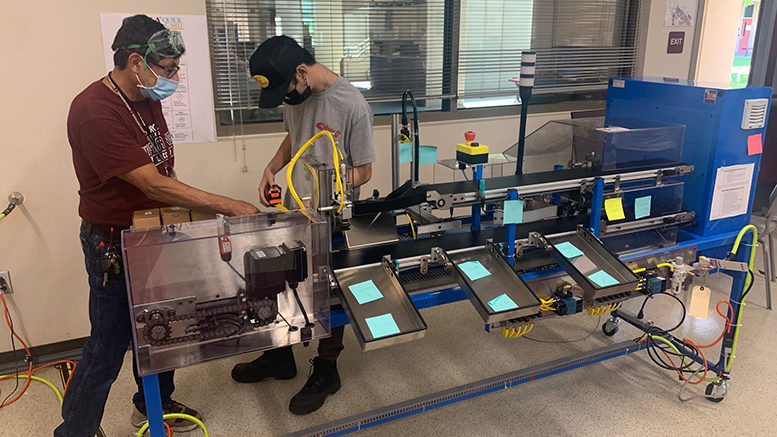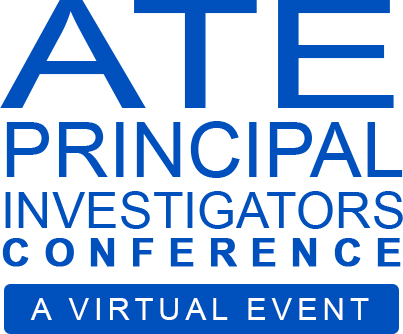The 28th Advanced Technological Education (ATE) Principal Investigators’ Conference opened Wednesday with a discussion of the nation’s supply chain that provided insights about the opportunities for community colleges and their students that exist amid the challenges of the skilled technical workforce in every industry from coast-to-coast.
“As a result of the pandemic, I don’t know that things have really changed, but things have sure accelerated…. Automation is coming and it’s coming fast,” said Paige VanFossen, vice president of operations in the e-commerce business unit at DHL Supply Chain.
The innovative programs that Advanced Technological Education projects and centers are developing to handle the many things coming fast – artificial intelligence, the internet of things, virtual reality, drones, career competencies, diversity, equity and inclusion – are the focus of sessions throughout the three-day virtual meeting. It is co-sponsored by the National Science Foundation (NSF) and the American Association of Community Colleges (AACC).
Strong support
“NSF is proud to be a partner of this work, and we are proud of the positive impact the ATE program has across the nation,” NSF Director Sethuraman Panchanathan said in a recorded address to the 900 educators and industry partners and 36 students attending the virtual conference. He noted that NSF has invested a total of $1.2 billion in the ATE program and “will continue to grow those investments and strengthen the phenomenal impacts that ATE and community colleges have on our communities and our economies.”
Related article: Amplifying ATE
Panchanathan said, “Our nation has a critical and growing need for a workforce with a broad range of technical skills and STEM capabilities. The health of the workforce is vital to America’s economic prosperity, our scientific and technological competitiveness and our national security community…. Your work is helping drive our economic growth and success, our global competitiveness and the prosperity of people and communities everywhere.”
Walter Bumphus, AACC president and CEO, expressed gratitude to Panchanathan and V. Celeste Carter, the lead program director of the ATE program, for NSF’s support of the ATE program and collaboration with AACC on the annual conference.
“Through the foundation’s leadership and financial stewardship, community colleges have been able to develop strong STEM technician education programs that are responsible and responsive to industry needs,” Bumphus said.
Automation and the skills gap
The three panelists who spoke about the supply chain during the opening plenary all mentioned ATE’s partnerships in positive terms.
VanFossen, who has been involved with the Ohio Supply Chain Academic Network (O-SCAN), said she is concerned that automation is exacerbating the skills gap as it replaces some workers and generates the need for more highly skilled technicians to operate complex, internet-connected equipment.
O-SCAN is an education-industry partnership created by the Collaboration of Midwest Professionals for Logistics Engineering Technology Education (COMPLETE), an ATE project led by faculty at Columbus State Community College (Ohio). It engages educators, retailers, service providers and government agencies in building logistics career pathways, mapping touchpoints between academia and industry, and promoting logistics career awareness at K-12 schools.
In 2020, 7,560 collaborators were engaged in ATE projects, according to data gathered by EvaluATE, the evaluation hub of the ATE program.
Since the ATE program started in 1993 in response to a Congressional mandate, NSF has required that the STEM technician education initiatives it funds with competitive grants involve two-year college faculty in leadership roles and industry in partnerships.
Communication among partners
Phil Gilkes, regional maintenance manager for Dollar Tree Stores, said close collaboration between industry and high education is key to addressing the skills gap that exists now and that has the potential to grow with more automation. Gilkes is an industry leader team member of the National Center for Supply Chain Automation (SCA) at Norco College (California).
“If we can work together between industry and higher education and understand what those gaps are – tailoring curricula to kind of address those gaps, and then implement programs that keep pace with advancements in technology, I think, you know, we’ll be in good shape,” he said.
Tom O’Brien, executive director of the Center for International Trade and Transportation at California State University, Long Beach and chair of SCA’s National Visiting Committee, reminded the ATE principal investigators to reach out to university educators who are unaware of the effective practices developed by the ATE program. He cited a 2+2+2 pathway program mentioned by an attendee in the chat during the discussion as an example. Connecting across education sectors, he said, “benefits our industry partners so we’re not part of the problem.”


